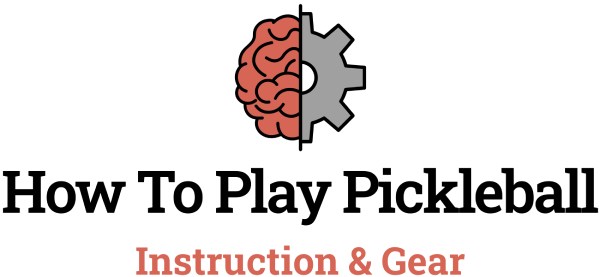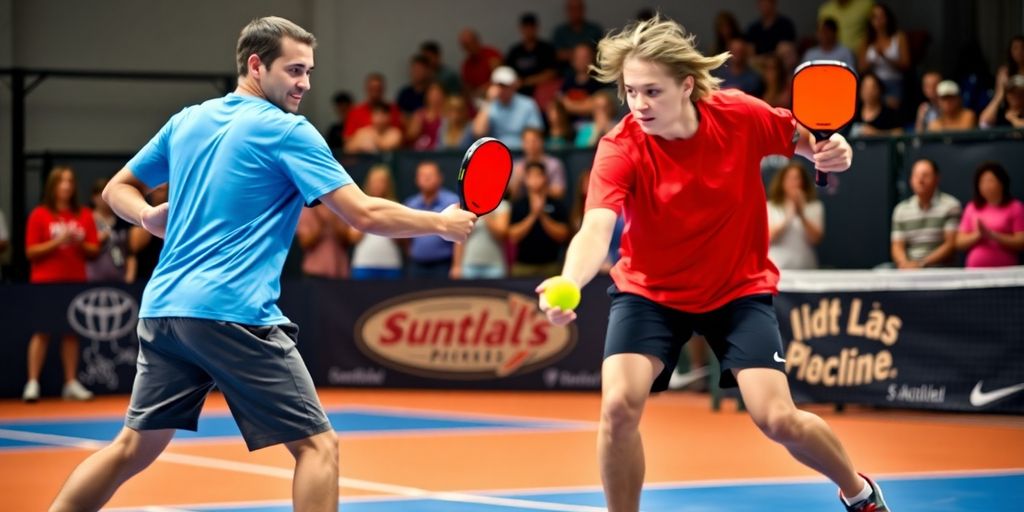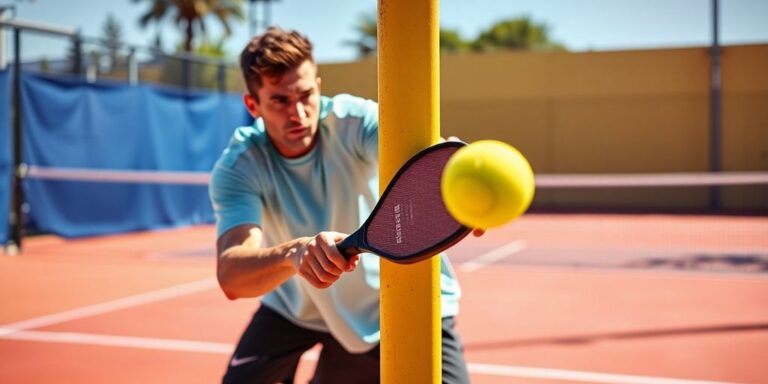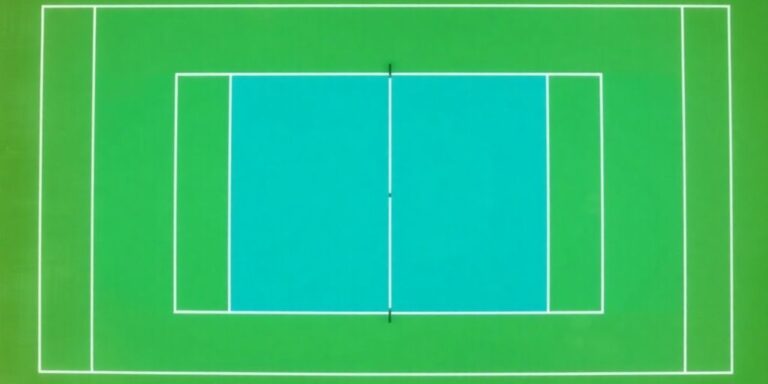Pickleball has quickly become one of the most loved racquet sports around, and it’s easy to understand why. It mixes strategy, speed, and a simple learning curve that attracts players of all ages. While many enjoy the social vibe of doubles, singles pickleball offers its own set of rules and challenges that really put a player’s skills and endurance to the test. If you want to step up your game and understand the ins and outs of singles play, this guide on pickleball singles rules is for you.
Key Takeaways
- Singles pickleball is played one-on-one, requiring players to cover the entire court by themselves.
- The serving rules differ slightly from doubles, with only one serve attempt allowed per point.
- Scoring is typically to 11 points, and you must win by at least two points.
- Kitchen rules apply the same as in doubles, meaning you can’t volley from the kitchen area.
- Effective strategies include getting to the net quickly and using a variety of shots to keep your opponent guessing.
Understanding Singles Pickleball
Singles pickleball is a different beast than doubles. It’s just you out there, covering the whole court. It can be exhausting, but also super rewarding. You really get to test your skills and strategy. Let’s break down what makes it unique.
Key Differences from Doubles
Okay, so the most obvious thing is that it’s one person versus one person. But that simple change has a ripple effect. Here’s a quick rundown:
- Only one player on each side, obviously.
- The scoring system is a bit different. We’ll get into that later, but it’s a two-number system instead of three.
- You only get one serve attempt. No second chances!
- Court positioning is different, too. You have to adjust your strategy since you’re covering the whole area.
Court Coverage and Movement
In doubles, you have a partner to help cover the court. In singles? It’s all on you. This means your movement and positioning are super important. You need to be quick, anticipate where the ball is going, and be ready to hustle. It’s a great workout, but it also requires some serious strategy. You can’t just stand in one spot and expect to win. You have to learn to control the court’s full expanse.
Game Dynamics
Singles pickleball is a faster, more aggressive game than doubles. You have to be ready to attack and defend at a moment’s notice. There’s less dinking and more driving. It’s a game of cat and mouse, where you’re constantly trying to outsmart your opponent. It’s also a mental game. You have to stay focused, even when you’re tired. One mistake can cost you the point. It’s a real test of skill and stamina. Understanding the pickleball singles rules is key to success.
Essential Singles Serving Rules
Serving in singles pickleball is super important. It’s not just about getting the ball over the net; it’s about setting yourself up for the point. Mess up the serve, and you’re already at a disadvantage. Let’s break down the key things you need to know.
Underhand Serve Requirements
Okay, first things first: the serve has to be underhand. I mean really underhand. The paddle needs to contact the ball below your waist when you hit it. No tennis-style serves here! Also, you have to hit the ball in the air; no bouncing it first. It’s gotta go diagonally across the court and land in the service area. If it doesn’t, it’s a fault. And remember, the serve needs to clear the non-volley zone, also known as the kitchen. It’s a lot to remember, but you’ll get the hang of it with practice. You can also do a drop serve if you want.
- Paddle contact below the waist.
- Underhand motion.
- Diagonal serve.
Serving Positioning
Where you stand to serve matters. It’s not just about picking a spot and going for it. Your position depends on the score. If your score is even (0, 2, 4, etc.), you serve from the right side of the court. If your score is odd (1, 3, 5, etc.), you serve from the left side. This might seem simple, but it’s easy to forget in the heat of the moment. Always double-check before you serve! This is part of the pickleball singles serve rules.
- Even score: Serve from the right.
- Odd score: Serve from the left.
- Stay behind the baseline.
One Serve Attempt
In singles, you only get one serve attempt. That’s it. No second chances. If you fault, you lose the serve, and your opponent gets the point. This is different from doubles, where you and your partner each get a serve. So, make that first serve count! Focus, take a deep breath, and aim for consistency. If you hit a let (the ball hits the net and lands in the correct service area), you get to re-serve. But don’t count on lets; aim to get it over the net cleanly every time. Remember to announce the score during a serve before you hit the ball.
Mastering the serve in singles pickleball can give you a huge advantage. It’s all about consistency, placement, and understanding the rules. Practice your serve regularly, and you’ll see a big improvement in your game.
Pickleball Singles Scoring System
Scoring to 11 Points
In singles pickleball, the goal is simple: be the first to reach 11 points. But there’s a catch! You can’t just hit 11 and win. You have to win by at least two points. This means if the score is tied at 10-10, you need to get to 12 before your opponent gets to 11. Games can sometimes go on for a while if both players are evenly matched. It’s not uncommon to see scores like 15-13 or even higher in competitive matches. Remember, only the serving player can score a point. If you lose the rally as the server, it’s a side out, and your opponent gets to serve.
Winning by Two Points
That two-point margin is super important. It adds a layer of strategy and tension to the game. Imagine you’re up 10-9. You’re so close, but you need to keep pushing. If your opponent scores, it’s 10-10, and the game continues. This can really test your mental toughness and ability to perform under pressure. It also means you can’t let up, even when you’re ahead. You need to stay focused and keep playing aggressively until you secure that two-point lead. This rule is one of the scoring rules that makes pickleball exciting.
Understanding the Two-Number System
Unlike doubles, where you have three numbers to keep track of, singles uses a simpler two-number system. The first number is always the server’s score, and the second number is the receiver’s score. So, if the score is 5-3, it means the server has 5 points, and the receiver has 3. It’s pretty straightforward, but it’s important to announce the score clearly before each serve to avoid any confusion. This helps ensure both players are on the same page and the game flows smoothly. It’s a small detail, but it makes a big difference in maintaining fair play. Remember, in singles, you only get one serve attempt, so make it count! If you are serving from the right (even) side if your score is even and from the left (odd) side if your score is odd. This is a key difference from doubles. Understanding the key differences is important.
Keeping track of the score is your responsibility. Don’t rely on your opponent to do it for you. Announce the score clearly before each serve, and double-check if you’re unsure. It’s better to be safe than sorry, especially in close matches.
Pickleball Singles Kitchen Rules

Okay, so the kitchen. It’s not just a place to grab a snack between games. It’s a crucial part of pickleball, and you gotta know the rules, especially in singles. It’s pretty similar to doubles, but let’s break it down.
Volleys and the Kitchen
The big one: you can’t volley while you’re standing in the kitchen or on the kitchen line. That means if the ball is coming at you and you’re in the no-volley zone, you gotta let it bounce before you hit it. No exceptions! If you do volley while in the kitchen, it’s a fault, and you lose the point. It’s that simple. This is where a lot of players mess up, especially when they’re trying to be aggressive at the net. Understanding its rules is key to avoiding those easy mistakes.
Bouncing in the Kitchen
Now, here’s where it gets a little tricky. You can be in the kitchen. You just can’t volley while you’re there. If the ball bounces inside the kitchen, you’re free to step in and hit it. But remember, once you’ve volleyed a ball outside the kitchen, you have to get both feet outside the kitchen line before you can volley again. Momentum can be a killer here. Don’t let it drag you back in!
Common Violations
So, what are the most common kitchen violations? Here’s a quick rundown:
- Volleying while standing in the kitchen.
- Stepping into the kitchen while volleying.
- Not re-establishing your feet outside the kitchen after a volley before the next volley.
It’s easy to get caught up in the heat of the moment and forget about the kitchen rules. Pay attention to your feet! A good way to practice is to drill kitchen shots specifically, focusing on footwork and making sure you’re always legal. Trust me, it’ll save you points in the long run. Also, remember to check out this guide for more information.
Knowing these rules will help you avoid faults and play smarter pickleball. Good luck!
Strategies for Singles Play
Getting to the Net
In singles, getting to the net is super important. It lets you control the pace and put pressure on your opponent. But you can’t just rush up there all the time. You need to pick your moments. A good, deep shot can give you the time you need to approach the net safely. Once you’re there, be ready for quick volleys and dinks. Don’t get caught too far back or too close – find that sweet spot where you can react to anything.
Effective Shot Selection
Shot selection is key in singles. You’re covering the whole court, so you need to mix things up to keep your opponent guessing. Don’t just hit the same shot over and over. Try different angles, speeds, and depths.
Here are some shots to consider:
- Dinks: Great for control and setting up attacks.
- Lobs: Can push your opponent back and give you time to recover.
- Passing Shots: Force your opponent to move wide.
- Dropshots: Catch your opponent off guard if they are far from the net.
Think about your opponent’s weaknesses. Are they slow moving to their backhand? Do they struggle with high balls? Exploit those weaknesses with smart shot selection. It’s like a chess game – every shot should have a purpose.
Defensive Techniques
Defense wins games, right? In singles, you’re covering a lot of ground, so you need to be solid on defense. Quick feet are a must. Always try to recover to the center of the court after each shot. This helps you cover both sides more effectively. Learn to anticipate where your opponent is going to hit the ball. Watch their body language and paddle angle. And don’t be afraid to use a defensive lob to buy yourself some time. Effective footwear is also important for quick movements.
Common Mistakes in Singles Pickleball
Singles pickleball is a blast, but it’s easy to slip up, especially if you’re used to doubles. Let’s look at some common errors players make so you can avoid them and improve your game. It’s all about learning and getting better, right?
Poor Positioning
One of the biggest mistakes is simply not being in the right spot on the court. In singles, you’ve got to cover a lot of ground, so your positioning is key. Players often hug the baseline too much or don’t adjust their position after hitting a shot. You need to anticipate where your opponent will hit the ball and move accordingly. Think about angles and court coverage. If you’re always out of position, you’ll be constantly on the defensive.
Neglecting Footwork
Good footwork is essential in singles. You can’t just stand there and expect to hit every shot perfectly. Players often shuffle their feet or don’t move quickly enough to the ball. Proper footwork allows you to get into the right position, generate power, and maintain balance. Practice your footwork drills to improve your speed and agility on the court. It makes a huge difference.
Inconsistent Serving
Serving is your first opportunity to gain an advantage, but many players struggle with consistency. Common serving faults include stepping over the baseline, hitting the ball too high, or not getting enough depth on the serve. An inconsistent serve can give your opponent easy points and put you on the defensive right away. Work on your serving technique to develop a reliable and effective serve. Aim for consistency and placement to put pressure on your opponent.
It’s easy to get caught up in the excitement of the game and forget about the fundamentals. But by focusing on these common mistakes and working to correct them, you can significantly improve your singles pickleball game. Remember, practice makes perfect, and even small improvements can lead to big results.
Benefits of Playing Singles Pickleball

Singles pickleball offers a unique set of advantages that go beyond just playing the game. It’s a great way to push yourself physically and mentally. It can really help improve your overall game, too. Let’s look at some of the specific benefits.
Improving Physical Fitness
Playing singles is a fantastic workout. You’re constantly moving, covering the entire court on your own. This means you’re getting a lot of cardio, which is great for your heart. Plus, all that running and quick changes in direction help build strength and endurance in your legs and core. It’s way more intense than doubles pickleball, where you can sometimes rely on your partner to cover certain areas.
Enhancing Skills
Singles forces you to become a more well-rounded player. You can’t depend on a partner to cover your weaknesses. You have to develop strong serves, solid returns, and consistent shots from all areas of the court. This focused practice can really boost your overall skill level. For example, strong serves are much more important in singles than doubles, so by playing singles these areas of your game will improve which will ultimately help your pickleball doubles game.
Boosting Mental Toughness
Singles is as much a mental game as it is a physical one. You’re out there on your own, making all the decisions and dealing with the pressure. This can really help you develop mental toughness and resilience. You learn to stay focused, even when you’re tired or frustrated. You have to strategize and adapt to your opponent’s game plan, all while managing your own energy levels. It’s a real test of your mental fortitude. Research indicates that playing racket sports, such as pickleball, enhances mental sharpness, reaction times, and overall cognitive function.
Playing singles pickleball can be a real grind. There’s no one to share the blame with when you miss a shot, and no one to cheer you up when you’re down. But that’s also what makes it so rewarding. When you win a tough singles match, you know you earned it all on your own. It builds character and teaches you to persevere, even when things get tough.
Playing singles pickleball has many great benefits! It helps improve your fitness, boosts your mood, and sharpens your skills. Plus, it’s a fun way to challenge yourself and meet new friends. If you want to learn more about how to get started and enjoy this exciting sport, visit our website today!
Wrapping It Up
So there you have it! Mastering the rules of pickleball singles can really up your game. It’s all about understanding how to serve, score, and move on the court. Whether you’re new to singles or just brushing up, knowing these rules will help you play better and have more fun. Remember, practice makes perfect, so get out there and play! Enjoy the game, and who knows? You might just find yourself loving singles even more than doubles!
Frequently Asked Questions
What are the main differences between singles and doubles pickleball?
In singles pickleball, only one player is on each side of the court. This means each player has to cover the entire court by themselves, unlike doubles where teamwork is involved.
How do I serve in singles pickleball?
You must serve underhand and below your waist. The serve should go diagonally across the court and must clear the non-volley zone.
What is the scoring system for singles pickleball?
Games are usually played to 11 points, and you must win by at least 2 points. The scoring is simpler, using a two-number system.
What are the kitchen rules in singles pickleball?
You cannot hit the ball while standing in the kitchen unless the ball has bounced in or near the kitchen first.
What are some common mistakes players make in singles?
Many players struggle with their positioning, forget to move their feet, or have inconsistent serves.
What are the benefits of playing singles pickleball?
Playing singles can improve your fitness, enhance your skills, and build mental toughness because you have to rely on yourself.




